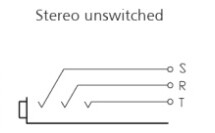Since the jack always has the smaller cross-sections the rated current always depends on the mated jack and not on the plug.
Yes, it’s possible to transmit digital-data as defined in the AES3-standard. If you use a patch panel in combination with digital signals you have to use plugs for the digital transmission. We recommend our Bantam(TT)-jacks which have gold plated contacts for best contact resistance.
There are different standards for plugs and jacks:
- IEC 60603-11
- EIA RS-453
- BPO 316
- MIL-P-642, MIL-J-641
Neutrik’s Standard ¼” Phone Plugs (A-Gauge) fulfill both, the IEC and EIA-Standard by using tighter tolerances and offering a special type for the MIL and the BPO-standard. (Longframe ¼” – TB type)
Some applications for the different types are:
- ¼” Professional Phone Plugs (Longframe A-Gauge) NP*C --> Consumer range like Guitars, Headphones (most common)
- MIL / B-Gauge (Longframe B-Gauge) NP3TB --> Professional broadcast and audio range, patch panels
- Bantam Types NP3TT --> patch panels
Plugs and jacks are usually used for transmittals of line-levels (0.775 volts). Their major applications are the connections of instruments like guitars, keyboards, headphones, ...
Plugs and jacks are used for microphone signals if you handle them with a patch-panel. Optionally they are also used for low power speaker applications.
There are two main groups of plugs and jacks:
- 2 pole connectors (TIP & SLEEVE)
- 3 pole connectors (TIP, RING & SLEEVE)
In the nonprofessional HiFi-area it’s common to use the 3 pole connector for stereo signals (headphones) and the 2 pole connector for mono signals.
In the professional broadcast and audio industry the 2 pole connector is used in combination with unbalanced cables for short and interference insensitive transmittals (guitar cable).
For more sensitive applications like digital transmissions or longer lines it is the custom to use 3 pole connectors together with balanced cables (to avoid EMI - electromagnetic interference), but it’s still a mono signal (balanced mono signal).
Switched jacks offer 2 or 3 additional switching (normalling) contacts. These TN, RN, SN contacts are closed in unmated condition and open when inserting a plug.

Our NP2C-T10AA plug has an inbuilt transformer to convert the signals.
If you use a "mono" (TIP/SLEEVE) plug it might be that you tried to connect an unbalanced line with a balanced line. The signal of a balanced line is split into +U/2 and –U/2. If you connect this balanced line with an unbalanced line you will just get the half voltage (gain) of the signal.
Professional Longframe patch panels like our NPP-TB contain B-Gauge jacks, therefore just B-Gauge connectors should be used (BPO 316 standard plugs like NP3TB).
Professional Bantam patch panels like our NPP(A)-TT use Bantam type jacks, therefore Bantam (TT) plugs (MIL-P-642/13 standard plugs like NP3TT) are the correct choice.
Semiprofessional patch panels like our NYS-SPP-L1 patch panel work with Standard ¼” jacks (EIA RS-453 A-Gauge longframe standard plugs like: NP*X, NP*RX, NP*C)